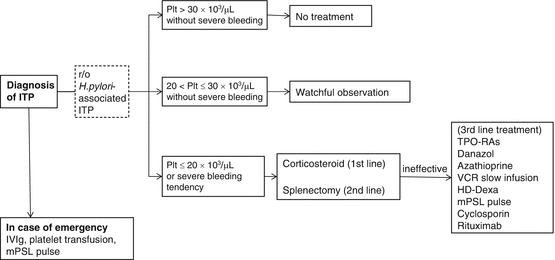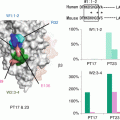Acute ITP
Chronic ITP
Peak age of incidence
Children (2–5 years)
Adults (20–40, 60–80 years)
Sex difference
Female/male = 1:1
Young onset
Female/male = 3:1
Old onset
Female/male = 1:1
Seasonal predilection
Winter–Spring
None
Antecedent infection
Common (1–3 weeks before) Vaccination
Unusual
Onset of bleeding
Abrupt
Insidious
Bleeding symptoms
Severe (hemorrhagic bullae in mouth is present in severe cases)
Absent in many cases
Prognosis
Spontaneous remissions occur within 6–12 months (an average of 4–6 weeks)
Persist more than 12 months
2 Clinical Manifestations
2.1 Hemorrhagic Manifestations
Platelets are essential for primary hemostasis, and thrombocytopenia leads to failure of prevention of blood leakage from small blood vessels. Purpura is the most frequent bleeding symptom in ITP. Purpura includes skin bleeding and mucous membrane bleeding, which are often referred as “dry” and “wet” purpura, respectively [12]. Since wet purpura is usually associated with lower platelet counts and the complication rates higher in those with wet purpura compared with dry purpura [1], wet purpura has been presumed as a sign of serious danger in patients [13]. However, there are no retrospective or prospective data to support the linkage of wet purpura and ICH [14].
Skin and Visual Mucous Membranes
Spontaneous bleeding into the skin is characteristic in ITP. Skin bleeding is classified into petechiae or ecchymosis by size. Petechiae is a red (recent) or purplish (a few days old) discoloration in the epidermis and dermis with a diameter of 0.5–3 mm, and ecchymosis is larger than a petechiae with red, blue, purplish, or yellowish green color [12]. In ITP, subcutaneous hematomas without contusions are rare. Gingival bleeding and epistaxis are common, and hemorrhagic bulla in the oral cavity may be seen in cases of severe thrombocytopenia.
Internal Mucosae of Organs
Bleeding in the genitourinary tract is common in ITP. Menorrhagia may be the only symptom of ITP. Hematuria is also a common symptom, although severe bleeding is rare. Severe bleeding in gastrointestinal tract is possible but rare even in patients with persistent low platelet counts [15].
The Central Nervous System
Although ICH is the most serious complication of ITP, it is fortunately uncommon. A systemic review of all prospective ITP studies that enrolled 20 or more patients showed that the rates of ICH were 1.4% in adults and 0.4% in children [8]. Higher incidence of ICH in cases of more than 60 years with low platelet counts is also reported [15], which may be due to frequent comorbidities or anti-hemostatic medications.
2.2 Thrombosis
Although thrombosis has not been considered a part of the spectrum of ITP manifestations, recent epidemiologic studies have revealed unexpected increase of thrombosis in ITP patients [16]. Four epidemiologic studies using large-scale databases from Denmark, the United Kingdom, the United States, and Sweden have been reported [17–21], and a meta-analysis of these observational studies showed that the incidence of arterial thromboembolism per 100 patient-years ranged from 1.0 to 2.8 among ITP patients and from 0.7 to 1.8 among populations without ITP; RR was 1.5 [95% confidence interval (CI): 1.3–1.8] [22]. The incidence of venous thromboembolism was also increased among ITP patients [ITP 0.4–0.7, without ITP 0.1–0.4 per 100 patient-years; RR 1.9 (1.4–2.7)] [22]. Several possible mechanisms of increase of thrombosis in ITP patients have been proposed, which are associated with ITP itself or ITP treatments. Increase of procoagulant microparticles has been reported in ITP [23], and endothelial damages caused by anti-GPIIIa antibodies [24] or antiphospholipid antibodies [25] may also affect the development of thrombosis. More importantly, many of ITP treatments, e.g., corticosteroids, high-dose intravenous immunoglobulin (IVIG), splenectomy, and thrombopoietin receptor agonists (TPO-RAs), may increase risk of thrombosis.
2.3 Treatment-Related Manifestations
A recent Danish population-based cohort study showed increased risk of mortality in ITP patients compared with the general population cohort due to cardiovascular disease (hazard ratio 1.5, 95% CI: 1.1–1.5), infection (2.4, 1.0–5.7), and hematological cancer (5.7, 2.1–15.7) in addition to bleeding (6.2, 2.8–13.25) [9]. These results suggest that ITP treatment-related comorbidities significantly affect prognosis of patients with ITP. Long-term administration of corticosteroids increases the risk of cardiovascular disease, and immunosuppressive therapy, including corticosteroids, increases the risk of infection and malignancy [26–28]. Splenectomy also increases the risk of severe infection [29, 30].
2.4 Quality of Life
Although prognosis of chronic ITP patients is fairly favorable even in the cases with severe thrombocytopenia, ITP itself and its treatments have significant impacts on daily life and physical, psychological, and social functioning. Studies using a health-related quality of life (HRQoL) questionnaire, which is a typical assessment tool of QoL, have been shown that the HRQoL of adult ITP patients was significantly worse than that of control population [31, 32]. In one study, HRQoL was worse than that of patients with hypertension, arthritis, or cancer and similar to that of patients with diabetes mellitus [31]. Fatigue is one of the common and distressful symptoms for patients with a chronic disease. It has been shown that a significant proportion of ITP patients suffer from fatigue, and many feel that they have less energy when the platelet count is low [33]. Despite improvement of thrombocytopenia, bleeding episodes, and QoL, TPO-RAs fail to show a consistent and clinically significant improvement in fatigue [34, 35], suggesting that fatigue in ITP patients is not simply associated with disease severity, and its mechanism is likely to be complex [33].
3 Algorithm of Treatment of Adult Chronic ITP
Before starting treatment of ITP, special attention to thrombocytopenia associated with H. pylori infection is needed in the regions of its high prevalence. Since a high prevalence of H. pylori and a high platelet response rate to its eradication are well demonstrated in Japan [36], a recent Japanese reference guide for management of adult chronic ITP recommends to screening and eradication of H. pylori when ITP is suspected, irrespective of platelet counts (Fig. 1) [37]. However, the value of the screening and eradication of H. pylori is uncertain in the regions of its low prevalence and a low platelet response to its eradication, like the United States [36, 38].


Fig. 1
The 2012 reference guide for management of adult chronic ITP published from the study group of the Specified Disease Treatment Research Program for Intractable Diseases of the Ministry of Health, Labour and Welfare of Japan [37]. IVIG intravenous immunoglobulin, mPSL methylprednisolone, TPO-RAs thrombopoietin receptor agonists, VCR vincristine, HD-Dexa high-dose dexamethasone
After exclusion of H. pylori-associated ITP, treatment of ITP should be initiated to maintain safe platelet counts as a goal. Although the safe platelet count may depend on age, comorbidities, and lifestyle of each patient, several observational studies have suggested that bleeding risk is increased with platelets below 20–30 × 103/μL [6, 15]. Therefore, many guidelines recommend treating patients with platelets below 20–30 × 103/μL and/or severe bleeding ([37, 39–42]). First-line treatment is corticosteroids, usually prednisolone. Seventy to eighty percent of patients will respond to prednisolone initially; however, sustained response would be achieved to a limited portion of patients, and 10-year disease-free survival is estimated as 13–15% [42]. Some studies demonstrated better sustained response of high-dose dexamethasone (HD-DEX) [43, 44]. A recent prospective randomized study performed in China showed that one or two courses of HD-DEX provided better initial response and less toxicity compared with conventional prednisolone therapy with the same sustained response rate [45]. Splenectomy has been recommended for corticosteroid-resistant patients as a second-line treatment. Splenectomy has a 60-year record of success for achieving durable remissions in approximately two-thirds of patients [46]. However, splenectomy increases lifelong risk of severe infection and thrombosis [29]. In elder patients, splenectomy may often be contraindicated because of comorbidity, and a favorable response may be less common in elder patients than in young patients [47]. For refractory ITP patients in whom splenectomy has failed or is avoided by patients’ and/or doctors’ decision, many drugs have been recommended as third-line treatments, although consistent better outcomes to refractory patients by randomized studies have been shown only in TPO-RAs. Two TPO-RAs, romiplostim and eltrombopag, are currently approved for use in adult ITP in Japan [48]. Randomized studies demonstrate that both drugs are highly effective in both splenectomized and non-splenectomized patients with minimal complications [49, 50]. Extended studies show sustained response and no increase of additional side effects in patients treated with TPO-RAs for up to 5 years [51, 52]. Off-label use of the anti-CD20 antibody rituximab to refractory ITP patients has been widely performed [53], and rituximab provides initial response rates of around 60% and sustained response rates of 20–30% [54]. Other third-line treatments may be also effective in some refractory cases [42, 55] (Table 2); however, the chances of administration of these drugs are very limited in these days because of considerable toxicity of these drugs and availability of TPO-RAs in addition to no approval for usage in ITP.
Dose | Response rate (%) | Time to response | Major toxicities | |
|---|---|---|---|---|
Azathioprine | 1–2 mg/kg/day | 40–60 | 3–6 months | Hepatotoxicity Neutropenia Pancreatitis |
Cyclosporine | 5–6 mg/kg/day | 30–60 | 3–4 weeks | Neurotoxicity Hypertension Paresthesia Gingival hyperplasia |
Cyclophosphamide | 0.3–1.0 g/m2 iv for 1–3 doses or 1–2 mg/kg orally | 24–85 | 1–16 weeks | Neutropenia Nausea |
Danazol | 50–800 mg/day | 10–70 | 3–6 months | Hepatotoxicity Acne Virilization |
Dapsone | 75–100 mg | 40–75 | 3 weeks | Hemolysis (in patients with G6PD deficiency) Rash Nausea |
Mycophenolate mofetil | 250–1000 mg | 11–80 | 4–6 weeks | Headache Diarrhea Nausea Anorexia |
Vinca alkaloids | Vincristine: 1–2 mg iv weekly × 3 weeks Vinblastine: 10 mg iv weekly × 3 weeks | 10–75 | 5–7 days | Peripheral neuropathy Fever Neutropenia |
In case of a requirement of rapid platelet increase because of bleeding emergency, surgical procedure, or delivery, IVIG is recommended [37, 39–42]. Administration of 5 days of 0.4 g/kg/day or 1–2 days of 1 g/kg/day IVIG leads to transient increase of platelet with peak on about 1 week after treatment in ~80% patients [42]. High-dose methylprednisolone may also be effective for rapid increase of platelet [56]. Platelet transfusion may be also effective for bleeding emergency, although higher dose of platelet concentrates may be required because of rapid turnover of infused platelets [57]. Platelet transfusion combined with IVIG may work better for rapid restoration of adequate platelet counts [58].
Stay updated, free articles. Join our Telegram channel

Full access? Get Clinical Tree




